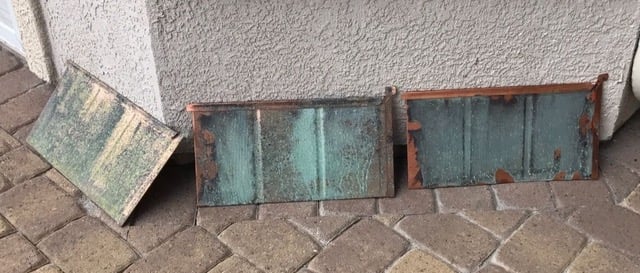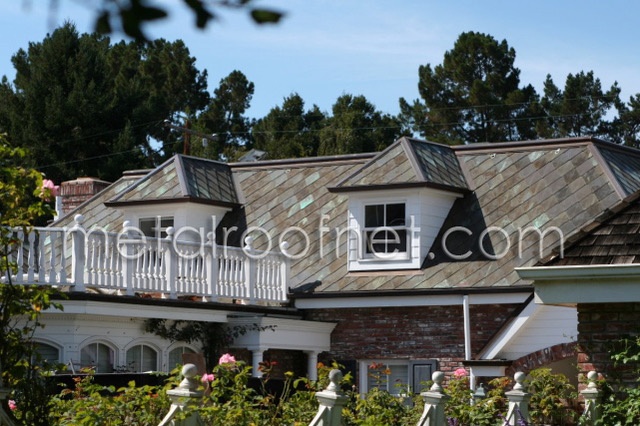I’m regularly asked about our pre-aged copper roof products, and it's usually someone requesting a particular shade of green or turquoise after viewing a roofing photo they’ve discovered on our website. They tend to ask whehter you can you fake the patina on a copper roof.
The question they're really asking is, can you accelerate the patina on a copper roof, as a fake patina would be a painted finish on a different kind of metal. And the answer is yes.
 This photo shows three different samples of patina applications on one of our copper shingle products recently prepared for an architect. The photo below shows the finishes result. The sample copper shingles were freshly treated and will darken considerably with exposure, but the color will remain mostly consistent for some time to come.
This photo shows three different samples of patina applications on one of our copper shingle products recently prepared for an architect. The photo below shows the finishes result. The sample copper shingles were freshly treated and will darken considerably with exposure, but the color will remain mostly consistent for some time to come.Here's Why
The copper patina that accumulates on copper roofing is a natural process that occurs with time and exposure to the atmosphere. Rain and moisture in the air react with the copper to turn the otherwise bright, shiny metal into a darker and darker gray/brown and, eventually, some shade of green. This process is happening to every natural copper roof that’s exposed to the weather, begins immediately, and continues indefinitely. It’s similar to steel rusting in the weather, in that it is a form of oxidation (what we call rusting when happening to iron and steel), but unlike most versions of steel the patina (another word for this visible layer of oxidation) forming on copper offers a significant degree of protection to the base metal from further oxidation. This patina (almost called verdigris) on copper is not only quite beautiful, but it’s also protecting the metal from corroding. As this process progresses, it will develop through many stages of colors, with the greens and blues showing up only after many years of exposure. The warmer and more humid the environment, the faster and deeper the green and blues develop. To the frustration of owners of cooper roofs in dry, cold, or desert climates, exposed copper can take multiple generations to oxidize to a visible green patina.
 While it’s easy to summarize the “how” of copper patina, what’s not easy is trying to emulate the appearance of an old copper roof. Since that’s exactly what many building owners want - without having to wait 25 years or more! - it’s not difficult to understand why the process of rapidly aging copper is something many attempt. It’s certainly not a new desire, as there are records in architectural notes explaining many ways of accomplishing this mission. There are more than a few instances when collected horse urine was poured on new copper roofs to make them appear old and green - with mixed (and noxious!) results.
While it’s easy to summarize the “how” of copper patina, what’s not easy is trying to emulate the appearance of an old copper roof. Since that’s exactly what many building owners want - without having to wait 25 years or more! - it’s not difficult to understand why the process of rapidly aging copper is something many attempt. It’s certainly not a new desire, as there are records in architectural notes explaining many ways of accomplishing this mission. There are more than a few instances when collected horse urine was poured on new copper roofs to make them appear old and green - with mixed (and noxious!) results.Because the process has been in demand for so long, there are chemists who have developed very good and very consistent treatments for the very purpose of creating copper patina very quickly. They are all some sort of acid with a mix of chemical additives designed to accentuate green, blue, gray, or black verdigris on copper. When we are asked to provide pre-aged copper finishes on our copper roof products, we always use the same mixes as they are predictable and safe. However, how they are applied will have the biggest impact on the final appearance of the finished job. Even using the exact same chemical, changes in the following conditions will dramatically effect the result: temperature, humidity, application technique, angle and exposure of surface, drying time. If any of these conditions change from one application to the next, then the result will be visibly different.
I like to let customers know that they can expect a certain type of look, and it will make them happy, but it’s not paint and they will likely never get a consistent, even shade of one type of patina green. Not to mention the fact that once the roof is installed and exposed, whatever result is achieved will continue to change and develop over time with exposure. It will usually become deeper and darker, with particularly intense areas where bird droppings or moisture can accumulate.
Always, however, they will have a iconic, copper roof with a patina emulating roofs that could be decades or centuries old.
Want to learn more about copper roofing?




